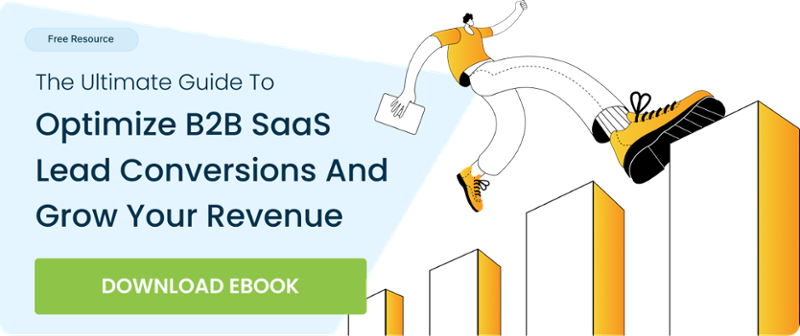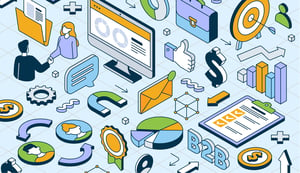‘Try it before you buy it.’
It’s the norm for B2B SaaS customers to expect a free trial to make a wise buying decision.
But what’s in it for you?
Free trials are a powerhouse to generate leads and revenue. And to take away profits off the table, you need to convert those free ones into paid accounts.
In this article, we will dive deep into the B2B SaaS free trial strategies to squeeze the maximum potential out of it.
What is a Free Trial in B2B SaaS?
Free trial is a limited-time offer where customers can enjoy the product features for free. The length of a free trial is usually between 7 to 30 days.
Post its expiration, it’s up to the customer to renew the services with a paid subscription.
Types of B2B SaaS Free Trials
1. Free Trial With Payment Details
It’s the scenario where the SaaS products provide a free trial after the lead adds the credit card information to the account. Unless the customer cancels their free trial, the payment is deducted to auto-renew the subscription.
It comes in handy to weed out the freeloaders and collect only quality leads.
2. Free Trial Without Payment Details
The businesses which let the leads enjoy the free trial without any credit card information fall into this category.
They might ask the customer for the email addresses to create the account and remind them about purchasing the subscription.
It’s guaranteed to fill your sales funnel with loads of deals.
3. Free Trial With Usage Limit
SaaS products grant some credits to the users for accessing the product, but once consumed, they are given a choice to pay for more.
Some businesses offer one-time credits, while others reload the credits after 15-20 days of expiration. It’s a great tactic to boost product stickiness and add real value to the customers’ lives.
4. Freemium Plans
There are also businesses that keep the product open for all except some premium features. If the customer wishes to access those, they can do that with a paid subscription.
Again, it’s helpful in showcasing the power of your product and convincing the customers to buy the full deck.
Should You Offer a Free Trial or Not For Your B2B SaaS Product?
Just because free trials are the new favorite of every SaaS business doesn’t mean it’s the must-do.
You can consider the following factors to decide whether you want to introduce free trials for your business or not.
1. The Complexity of the Product
A free trial doesn’t promise successful conversion if the customer isn’t able to extract any value from it.
Your free trial should offer enough value to the customer to keep them hooked. If your product is too clunky, the customer might not be able to navigate quickly and will eventually lose interest.
Next, check if you would be able to assist the free trial users with ample reference documents, training videos, and a helpdesk, to answer their queries.
2. The Reputation of Your Brand
Will you share your credit card details with a random person? No, right!
Similarly, you can’t expect customers to trust any off-the-shelf brand with their money.
Consider your brand reputation first if you are offering a free trial with payment details or even seeking better conversions. See if people trust your brand and services or not.
3. Your Ideal Customer Persona
Next, drill down your ideal customer persona, right from the basic demographics to the exact market demand.
For example, if your niche audience is aged between 18-25, they might not have credit card details to enroll for a free trial with payment details. That’s why you need to tailor your product trial in a manner that brings back the customers for more.
4. The Length of Your Sales Cycle
The free trials are a customer acquisition strategy to boost revenue.
But if your sales cycle eats a lot of time, your leads will go cold, and the funnel will dry up.
So to optimize your operations, plan how you are going to engage with trial users and close the deal.
How Long Should the Free Trial Be?
Around 99% of SaaS businesses believe 14 days is the perfect duration for a free trial.
Let’s take a look at why shorter trial periods work better for SaaS businesses.
1. Better Product Adoption
Will the customers use your product daily for the next 30 days of the trial?
Though some might, a majority will probably get too busy or forget all about it.
A shorter trial period will keep the users hooked and excited to reap the benefits. It will influence the customers to realize the value of your product and boost stickiness.
2. Lower Customer Acquisition Cost
Hitting the iron while it’s hot will yield better results in a shorter time.
If your customers are engaged with your product and find it the perfect match for them, they will want to renew the subscription to continue the trend.
And since the customers will actively reach out to you, it will reduce the sales cycles, saving you money on marketing and sales efforts.
3. More Engagement & Revenue
It’s a psychological effect where customers have a few days to try your product, so they will actually feel motivated to do so.
Since the engagement levels are high, customers are more likely to renew their plans. Thus, adding to your business revenue.
It’s understandable to worry that your sign ups might go down with a shorter trial period. And it might even be true. But even this is an advantage for you as it will attract only genuine leads to your product.
A smaller but the right group of users will only compound your gains in the long run rather than those who sign up on all products but use none.
How to Convert Free Trial Users Into Paid Customers?
1. Set the Record Straight
Outlining clear expectations from the get-go boosts the customer’s confidence and increases your conversion chances.
Share complete information with the users while they are signing up for the free trial. Include an explicit section for the terms and conditions to avoid any conflicts later.
Here’s what you must share with your users.
- What’s the duration of the trial period?
- Which product section is accessible in the trial, and which isn’t?
- Is credit card information required, and will automatic deduction happen once the free trial ends?
- Do the users have an option of canceling the subscription amidst the free trial or not?
2. Reduce the Learning Curve
A smooth onboarding process significantly boosts the chances of conversions as the user gets the desired value from the services.
If you leave the users to navigate for themselves, they might be unable to extract the maximum throughput from it.
- Send a welcome email to the users signing up with information about the brand, the login process, and what they should expect.
- Accompany the emails with training videos and reference documents.
- Guide them on how they can reach out to the support team via tickets or other communication channels.
- Allocate a dedicated customer success manager who can provide the initial hand-holding to the users.
3. Attract With Additional Discounts
Entice the customers with a special discount if they purchase the paid plan before the free trial expires.
It’s a win-win situation for those users who are genuinely interested in the product. They can purchase the services at a lower market price while the businesses get an early conversion.
4. Maintain Regular Engagement
The customers’ attention span is really low.
That’s why you should aim to bring the users back to the product every day, even if it’s only for a few minutes.
Regular interaction between the customers and the product is necessary to keep them interested in the value you provide. Otherwise, the users can sway to other options available in the market.
- Send tips on how they can optimize product use.
- Use pop-ups in the product to guide the users on features.
- Embed a timer to remind the users when their free trial is ending.
5. Remove Hassles From Payments
The whole endeavor is to get user conversions, but how easy is it for the subscribers to shift to a paid plan?
- Inform the users of the available plans and the features they can enjoy.
- Don’t hide the plan upgrade option in the product. Make it big, clear, and accessible.
- Incorporate a reliable payment gateway for smoother transactions.
And Then What?
A successful conversion doesn’t end your work.
Now, the goal should be to retain those customers with active engagement and proactive services. Stay in regular touch to further update them about new features and how to optimize existing ones.
Share crucial analytics and reports to help them improve their product adoption and performance. Remember that your customers are bringing in revenue for you only till you make their life easy. So, focus on value and a data-driven approach to engage with customers.


